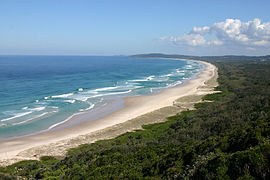Northern Rivers (New South Wales)
|
Northern Rivers New South Wales |
|||||||||||||||
|---|---|---|---|---|---|---|---|---|---|---|---|---|---|---|---|

View south from Byron Bay, the most easterly point on mainland Australia.
|
|||||||||||||||
| Population | 296,531 (30 June 2016) | ||||||||||||||
| • Density | 14.30264/km2 (37.04368/sq mi) | ||||||||||||||
| Area | 20,732.6 km2 (8,004.9 sq mi) | ||||||||||||||
| State electorate(s) | |||||||||||||||
| Federal Division(s) | |||||||||||||||
|
|||||||||||||||
Northern Rivers is a region of the Australian state of New South Wales, located between 590 kilometres (370 mi) and 820 kilometres (510 mi) north of the state capital, Sydney. At its most northern point, the region is 102 kilometres (63 mi) south south–east of the Queensland capital, Brisbane.
As with all regions of New South Wales, it has no official status, although state government department offices and local governments in the area work together for purposes such as tourism, education, water catchment management and waste management. This area has a mild, sub-tropical climate.
The Northern Rivers region is bounded by the Pacific Ocean to the east, the New England region to the west where the Great Dividing Range forms a mountainous boundary. To the north is the border between New South Wales and Queensland, where the Darling Downs are located to the north–west and South East Queensland directly to the north. The southern boundary is the Dorrigo ranges, which also mark the southern boundary for the Clarence River Basin.
The defining characteristic of the region are the fertile valleys of the Clarence, Richmond and Tweed rivers and their sources, hence the region's name; and the region's white sandy beaches.
The following local government areas are contained within the region:
The region is traversed by the Pacific Highway, Bruxner Highway, Clarence Way, Summerland Way and the North Coast Line which links Sydney to Brisbane, Queensland.
...
Wikipedia
